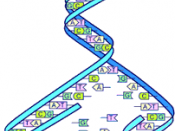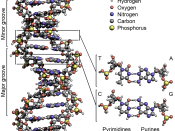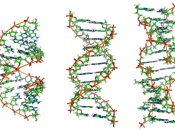-DNA is a polymer of nucleotides
-Each nucleotide consists of a nitrogenous base, a sugar, and a phosphate group
-The sugar in DNA is a pentose sugar called deoxyribose
-The different kinds of bases are adenine, thymine, guanine, and cytosine
-In DNA, there is a 1:1 ratio of nucleotide bases: number of adenine = number of thymine and number of guanine = number of cytosine
-DNA consists of 2 strands in a shape called a double helix
-Double helix is 2-nm in diameter
-The strands have a sugar-phosphate backbone
-The two strands are held together by hydrogen bonds
-The rungs of the helix consist of purine/pyrimidine rings
-Adenine and guanine are purines
-Purines have two organic rings
-Cytosine and thymine are pyrimidines
-Pyrimidines have a single organic ring
-Pyrimidines pair with purines to form rungs of helix (adenine with thymine and guanine with cytosine)
-Adenine and Thymine form 2 hydrogen bonds
-Guanine and Cytosine form 3 hydrogen bonds
-The helix makes one full turn ever 3.4
nm along its length
-Bases are stacked .34 nm apart
-Ten layers of base pairs in each turn of the helix
-Replication is explained by the Semiconservative model
-When a double helix replicates, each of the two daughter molecules will have one old strand derived from the parent molecule and one newly made strand
-DNA replication involves unzipping the DNA molecule into 2 strands
-Each strand acts as a template to assemble a new, complementary strand
-Results in two identical double-stranded molecules of DNA
-How DNA replication occurs
-Helicase unwinds the DNA forming a replication fork (Y-shaped region where the new strands of DNA are elongating)
-Single-stranded DNA binding proteins prevent single strand of DNA from recombining
-RNA Primase initiates DNA replication at special nucleotide sequences called origins of replication. RNA Primase uses short...


